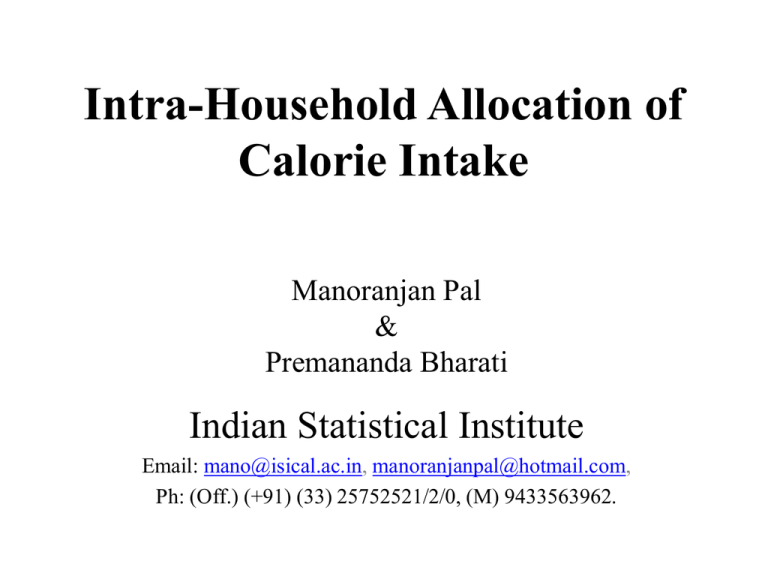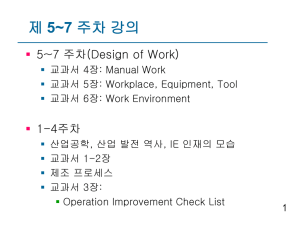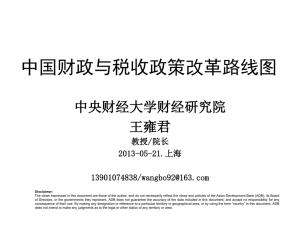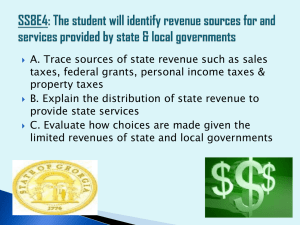
Intra-Household Allocation of
Calorie Intake
Manoranjan Pal
&
Premananda Bharati
Indian Statistical Institute
Email: mano@isical.ac.in, manoranjanpal@hotmail.com,
Ph: (Off.) (+91) (33) 25752521/2/0, (M) 9433563962.
Preliminaries: Regression
• A variable is predicted using one or more
variables.
• It can not be predicted exactly.
• We minimize the prediction error to estimate
the parameters.
Preliminaries: Artificial Generation
of Regression Problem
• How can we set a regression problem artificially?
• We construct it.
• E.g., We take a linear equation:
y = a + bx + cz
Put a=2, b=3 and c=1.5
For different pairs of values of (x, z) calculate y
using the above equation.
For x=3 and z=4, we have y=2+3*3+1.5*4=17, and
for x=-1 and z=2, we have y=2+3*(-1)+1.5*2=2,
and so on. The following table gives an example of
artificially generated set of observations.
Preliminaries: The Regression
Estimates
• The regression estimates found in the above
artificial example are
a = 1.355
b = 3.055
and
c = 1.546.
• The estimate of the intercept term differed from
the actual value more than those of b and c. This
is because the sum of the error terms was not
close to ‘0’ and we have assumption that E(e)=0.
Preliminaries: Discussions
• In the artificial regression the estimate of ‘a’ has
more standard error than those of ‘b’ and ‘c’. I.e.,
estimates of ‘b’ and ‘c’ are more robust.
• The regression technique can be used to estimate
the unknown parameters in identities of the form
y = ∑bixi,
where bis are unknown. These identities may be
termed as Regression Decomposition Identities.
Preliminaries:
Regression Decomposition Identities
• Examples of Regression Decomposition Identities:
Total Expenditure of Cereals in a household (y)
= Sum of Expenditures on Different kinds of Cereals.
= Sum of Products of Prices and Quantities of Different kinds
of Cereals (∑bixi),
where bis are prices (unknown) and xis are quantities
(known).
• In the above example we should not assume bi s as quantities
(unknown) and xi s as prices (known), because some
commodities are not purchased at all i.e., the quantity is ‘0’.
The variations in the quantities purchased will be much. If we
do that, the coefficients will give us the average quantity
purchased by the households taken in the analysis.
• On the other hand prices will not vary much.
Preliminaries: Regression
Decomposition Identities
• Another
Examples
Decomposition Identities:
of
Regression
• Total calorie intake in a household is the sum of
the calorie intakes of the male and female
members in the household, where the calorie
intake of a male/female members is the product of
number of members and the average calorie intake
of a male/female member.
• This will give us a measure of intra-household
gender inequality of consumption.
Preliminaries: Regression
Decomposition Identities
• There is a problem in the above example.
Problem: There is much variation in the consumption
among male/female members due to variation in ages.
Solution: This problem can be tackled by taking
number of male and female members in each age (in
years) in the household. In most cases it will be 0 or 1.
This will give us age wise gender inequality in the
calorie intake.
The Model:
y = a+b1x1+b2x2+ …+b100x100+c1z1+c2z2+ …+c100z100+e,
assuming that the maximum age possible is 100.
Preliminaries: Regression
Decomposition Identities
The Model:
y = a+b0x0+b1x1+b2x2+ …+b100x100+c0z0+c1z1+c2z2+
…+c100z100+e,
assuming that the maximum age possible is 100.
Problem: Too many regressors. Difficult to handle.
Solution: Take age groups, say 0-3 years, 4-6 years, 712 years, 13-18 years, and so on for both males and
females. Same age groups should be taken for both
males and females. Otherwise comparison is not
possible.
Aim of this Paper
We are interested in knowing whether
there is any difference in the consumption
of food between male and female
members in the households in India.
The consumption of food is summarized here
through the mean calorie consumption of male
and female members in each Age Group.
Human Energy Requirements
“Energy requirement is the amount of food energy
needed to balance energy expenditure in order to
maintain body size, body composition and a level
of necessary and desirable physical activity
consistent with long-term good health.”
However since there are interpersonal variations, the mean
level of dietary energy intake of the healthy, well-nourished
individuals who constitute that group has been recommended
as the energy requirement for the population group.
Calculation of Human Energy Requirements
• Calorie consumption should be different for different types of members in
the household.
• The estimates of human energy requirements from measures of energy
expenditure plus the additional energy needed for growth, pregnancy and
lactation are given in the final report of the Joint FAO/WHO/UNU Expert
Consultation on Human Energy Requirements, convened in October 2001
at FAO headquarters in Rome, Italy.
• It is also necessary to have information on the lifestyles of adults in relation
to the intensity of habitual physical activity. All adults are put in one of the
three categories (i) sedentary or light activity lifestyle, (ii) active or
moderately active lifestyle and (iii) vigorous or vigorously active lifestyle.
Total Energy Expenditure (TEE) will be different for different lifestyles.
•
The procedure for measuring Total Energy Expenditure (TEE) is through experiments like Doubly
Labeled Water technique (DLW), Heart Rate Monitoring (HRM). When experimental data on total energy
expenditure are not available, factorial calculations based on the time allocated to activities can be adopted.
Factorial calculations combine the energy spent on different components or factors like sleeping, resting,
working etc. that are performed habitually.
Table 2. Energy Requirements of Infants
During the First Year of Life
Table 3. Energy Requirements of Boys and
Girls at Different Age Groups: FAO
Table 4. Energy Requirements of Boys and Girls at
Different Age Groups: A Comparison Between FAO
and ICMR Estimates
Table 5. Classification of Lifestyles in Relation
to the Intensity of Habitual Physical Activity
Level (PAL)
Basal metabolic rate (BMR): The minimal rate of energy expenditure compatible
with life. It is measured in the supine position under standard conditions of rest,
fasting, immobility, thermoneutrality and mental relaxation. Depending on its use, the
rate is usually expressed per minute, per hour or per 24 hours.
Physical activity level (PAL): TEE for 24 hours expressed as a multiple of BMR, and
calculated as TEE/BMR for 24 hours. In adult men and non-pregnant, non-lactating
women, BMR times PAL is equal to TEE or the daily energy requirement.
Table 6. Daily Energy Requirements for Men
and Women in India
Table 7. Energy Requirements of Boys and Girls at
Different Age Groups: A Comparison between FAO
and ICMR Estimates
The Model and the Methodology
yh = ch1 xh1 + ch2 xh2 + … + chK xhK
where ch1, ch2, …, chK are the actual per head calorie consumptions of the respective
categories. In general ch1, ch2, …, chK will vary from household to household.
chk = βk + uhk, for k = 1, 2, 3, …, K
where uh1, uh2, …, uhK are the deviations of the actual calorie consumption from the
respective mean values.
The deviations uh1, uh2, …, uhK, have zero means. We also assume that this
deviation for a single person in that category have same variance for all the
households and is denoted by νk2, k = 1, 2, …, K. We can thus rewrite the above
identity as
yh = (β1 + uh1) xh1 + (β2 + uh2) xh2 + … + (βk + uhk) xhK
or yh = β1 xh1 + β2 xh2 + … + βk xhK + εh,
where εh = ∑k uhk xhk.
Distribution of Error Terms in the Model
We assume that the deviations uh1, uh2, …, uhK, have zero means. Also the errors are
independent over households. I.e., the errors in one household are independent of the
errors in the other household. The dispersion matrix of uh1, uh2, …, uhK is Φh. The
variance of εh, V(εh), is thus V(εh) = σh2 (say) = xh´ Φh xh, where xh is the household
composition vector and Φh is
where φij, i≠j, is the covariance between uhi and uhj and φii is the variance of uhi also
denoted by νk2.
Introducing the Intercept Term
The hth equation can now be written as
yh = xh´β + εh.
Total expenditure on food includes expenditure on food offered to guests, servants
and other visitors of the house. Also some members of the household may avail food
outside the house which is not reflected by the total food expenditure. Thus total
calorie consumption of the household implied by the food expenditure may be greater
or less than the sum of calorie consumption of the individual members. This deviation
can be accommodated in the intercept column of the regression, if introduced. We
thus redefine the above equation by redefining xh as
xh´ = (xh0, xh1, xh2, …, xhK),
where xh0 = 1 for all h. The coefficient of this is β0, which is the expected value of the
deviation. The new β vector is β´ = (β0, β1, …, βK). εh, Φh, σh2 etc. are suitably
reformulated as σh2 = xh´ Φh xh, where Φh is
where φij, i≠j, is the covariance between uhi and uhj and φii is the variance of uhi also
denoted by νk2.
The Regression Equation
With this formulation we can now write all the equations in a compact form as
y = X´β + ε
where y = (y1, y2, …, yH)´, ε = (ε 1, ε 2, …, ε H)´, and
The dispersion matrix of ε is
Ω = diag(σ12, σ22, …, σH2).
Interpretation of the Regression Coefficients
•
•
•
•
•
Each element in β gives the expected amount of calorie consumption for a member
in the respective category.
This may also be interpreted as the increase in the average amount of calorie
consumption due to increase by one person in the respective category.
Usually in regression analysis one can give both the interpretations of the estimated
coefficient if the intercept term is not significant. Interestingly, in this case, both the
interpretations are plausible even if the intercept term is significant i.e., the sum of
individual average calories is not the total calorie on the average.
If the intercept term is positive, it means that there is extra consumption, possibly
by guests or servants for many of the households which outweighed the
consumption of food by the members of the households outside the house. If it is
negative the interpretation is the other way round.
The variable associated with the intercept term always takes value 1. Thus it may be
interpreted as a ‘ghost’ member in the household which may consume or produce
extra calories for consumption of other members.
Estimation of Parameters
The Generalized Least Squares (GLS) estimate of β is
(X´ Ω-1X)-1(X´ Ω-1y).
However Ω is not known. It is a diagonal matrix with σh2 (= xh´ Φ xh) as its hth element.
I.e.,
To estimate the φ values we first get the usual regression (weighted least squares using
multipliers as weights) estimate of β.
Use this to get the residuals and regress the square of the residuals on (1, 2xh1, 2xh2,
…, xh12, 2xh1xh2, …). The regression coefficients will give us the estimates of the
distinct elements of φ’s, namely, (φ00, φ01, …, φ0K, φ11, φ12, …, φ1K, …, φKK). This can
be used as GLS estimate of β. The process can be repeated until convergence up to
desired level of precision.
The Proposed Estimation Procedure
• The non-negativeness of the estimated value of σh2 for each h
is not guaranteed because the estimated value of Φ may not be
nonnegative definite. It was in fact found to be so with our
consumption data of 61st round of NSSO. Deleting the data
associated with negative σh2 did not help. There were further
some negative σh2 and the process did not end quickly.
• To overcome this problem we have taken Φ to be diagonal
with only φ11, φ22, …, φKK. Thus we regressed the square of
the residuals on xh12, xh22, …, xhK2. All the coefficients of xh12,
xh22, …, xhK2, this time, were positive for most of the subsets
of data considered for our analysis. For the few cases where all
the coefficients were not found to be positive, we deleted a
very few observations to achieve the desired result.
The Data
NSS 61st round data has 124644 households. After scrutiny and
elimination of outlying observations it reduced to 124362 households.
The following gives the summary of the data before and after scrutiny.
The number of observations deleted is not much compared to the total
sample size.
The NSS data provides multiplier to each household. The multiplier is
calculated from the sampling scheme adopted by NSSO. This can be
used as weights to get more accurate estimates. We have used SPSS
11 and SPLUS 2000 for our calculations.
Three Types of Estimation Procedures
• According to the Table 8, coefficients associated with
the male members have higher values than those of the
female members in most of the cases .
• The estimates varied to some extent over the three
types of estimation method.
• The coefficients, i.e., mean consumption of calories,
decrease for most especially among members in the
lower age groups when we switch to better estimation
procedure. However, the mean calorie consumptions
for female members remain less than those of male
members.
Table 8. All India Average Calorie Intake of Members of
Households by Age Group and Sex
Comparison of Our Estimates With
FAO and ICMR Norms
• It should be remembered here that the calorie norms of female
members given by FAO and ICMR are also less than or equal
to those of corresponding male members. So it is difficult to
say whether the differences in the calorie consumption
between male and female members are as expected or due to
gender inequality without comparing these ratios. The
comparison is given in the Table 12.
• The gender ratios of the proposed model are seen to be
less than the gender ratios found from the norms given by
FAO and ICMR among members in the lower age groups
and higher among the members in the higher age groups
and adults.
Table 12. Age Group wise Comparison of F/M Ratios
with Corresponding FAO and ICMR Norms
Results by Expenditure Groups
• It is felt that the treatment on the members would be different for different
income/expenditure levels. We grouped the households into 12 expenditure
groups. Group 1 has the lowest and the Group 12 has the highest per capita
expenditures. Rural and urban expenditure groups are different.
• The groups are same as the ones taken by NSSO.
• The results of the regression analysis are much different now. This time all
the coefficients have increased substantially. This is seen more among the
members in the lower Age Groups and in the households with low per
capita expenditures. The intercept terms are found to be very small or
negative for the lower expenditure groups. This signifies that some
consumptions were not taken into account for the lower expenditure group
households. The members consumed food outside the house or received
food in kind which have not been reported. Similarly, by the same logic,
because of high positive values of the intercept terms, it can be concluded
that some expenditure on food have been incurred by higher expenditure
group households and possibly consumed by members from outside the
households which have not been reported.
Table 9. Average Calorie Intake of Members of Households
by Age Group, Sex and Expenditure Group in Rural India
Table 10. Average Calorie Intake of Members of Households
by Age Group, Sex and Expenditure Group in Urban India
Table 11. All India Average Calorie Intake of Members of
Households by Age Group, Sex and Expenditure Group
Results
• The consumption ratios between female and
male members are found to be more or less
same for all age groups for each expenditure
class. Most of the ratios are less than 1.
Number of expenditure groups with ratio more
than 1 was more among the lower Age Group
members especially in Urban India.
The Expenditure Group Wise Regression Results
• The Expenditure Group wise regression results and
ratios relative to those of FAO and ICMR are given in
Tables 13 through 15. The Gender ratios are found to
be more than the gender ratios obtained from the FAO
and ICMR norms for most cases. Among the adults
and the members in the Age Group 13-18 years it is
found to be true for almost cent percent. Even among
the lower Age Group members our estimates of the
ratios are seen to be more than the corresponding
ratios of FAO and ICMR in almost half of the cases.
Table 13. Age & Expenditure Group Wise Comparison of
F/M Ratios with Corresponding FAO and ICMR Norms:
Rural India
Table 14. Age and Expenditure Group Wise
Comparison of F/M Ratios with Corresponding FAO
and ICMR Norms: Urban India
Table 15. Age and Expenditure Group Wise
Comparison of Estimated F/M Ratios with
Corresponding FAO and ICMR Norms: All India
Conclusions
•
•
•
•
To conclude, the present data do not give any indication of inequality against
female members in the households at all levels of income except for the Age Group
4-6 years at high income levels.
On the contrary the results indicate that the gender inequality may be present
against male members especially the grown up members in the households.
The differences in the ratios in the Age Group 4-6 years between our estimates and
those of FAO and ICMR should be further looked into.
There are however certain limitations in our analysis.
(i) We have not considered the activity patterns of the adult members in the
households. For calculations of calorie norms the adults are usually put in one of
the three groups according to the activity pattern or life style – sedentary life style,
moderately active life style and vigorously active life style.
(ii) Since male members are more actively involved, it is expected that if we
consider the activity patterns, the results will indicate more discrimination against
male members in the households. Whether one should term it as discrimination or
self imposed less consumption by the male members remains a question.
Thank you








